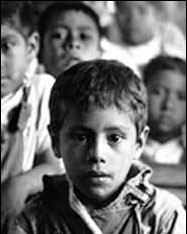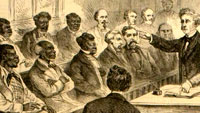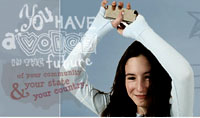Introducing Artifacts to Students (and Teachers)
Elspeth Inglis and Kim Laing explore the benefits of teaching history with artifacts, not just text. Based on their own experiences with teaching children and history educators, they suggest introducing an unfamiliar object to students and letting students form their own hypotheses about the object's identity. The questioning skills learned from such active, inquisitive engagement with objects can invigorate both learning and teaching.
Elspeth Inglis: I call it teaching in three dimensions. I did have a short stint teaching high school history, right out of college—and I didn't feel that I knew what to do teaching from a book—teaching history from a book. I had some fun with literature, but teaching history from a book did not come easily to me. I think there are some teachers who know how to do that and some of us don't. I had to have props. I had to have things.
And so my whole museum career related to education—working with children and working with teachers—has always, always, been focused on how do we use objects of everyday life? Works of art, architecture, monuments, any thing that has been made or used by a human being is fair game in my book.
So I usually begin any class on 'what is history?' with an object. And I try to find a mystery object—something that my students, no matter what their age, might not have ever seen. And I do this on purpose, because I want to demonstrate first and foremost how difficult it is to understand history when you take a nugget of information out of context. It is very hard to understand something that you have had no experience with.
So, you know, if a teacher would to walk into a classroom one day, say, she is going to teach pioneer life, and she immediately says to her students "Imagine being a pioneer," the students have nothing with which to spark their imagination. But if that same teacher walked into her classroom and she had a straw hat and she had a cow horn cup and she had a wooden bowl, a candlestick, etcetera, etcetera. And then she tried to get her students to imagine being a pioneer because these are the things that a pioneer would wear, use, or make, etcetera. Then we are getting somewhere, I think, because we are building on experience.
Elspeth Inglis: I find that children really do connect with objects and that they really can have a deep, deep understanding of those objects. It might not be the same understanding you or I have as educators but we have to acknowledge what that student's experience is first and then try to broaden their experience using that artifact.
So I do mystery artifact investigation, that is, that begins with simple observation—descriptives—what is this thing made of? How big is it? What does it weigh? You could do all kinds of observation skills like that. I don't allow them to make guesses about what it does until after they've thoroughly, thoroughly examined the physical properties of the object and test it. Does it have any moving parts? Does it look like something is missing? Does it belong to something else?
Then after they've really exhausted all of those basic observations, I start asking for their ideas about what the thing might do. And if a student responds with—it really doesn't matter what the answer is, I never tell them whether they are right or wrong about what the object is. That is not the point of the exercise. The point of the exercise is to get them thinking and to get them questioning.
And so if, and here is an example I used yesterday, if you know what a candle mold looks like, it's got, you know, cylinders—usually, six, four, it can be many different numbers of cylinders—and it's tin, and it's got a handle, and a place for you to pour the wax. So when I present this to children, and I have been doing this particular artifact for many years, and many times I get the answer from children that they think it's a hot dog cooker. OK, if it's a hot dog cooker, why don't you tell me, or do a pantomime and show me, how this hot dog cooker would work. And the children begin to, you know, pantomime putting the hot dogs in, putting it in the fire, and then you can see—you can see what's happening on their faces as they think this through.
And I say to them, how do you get this out of the fire—because we're talking about before microwaves and stoves, they all know this at this point. And they say, well, you have to have something long because, because they know the metal gets hot and you can't just reach in and hold the handle. Then I ask them what happens to a hot dog when it cooks. Every 4th grader knows that hot dogs expand when they cook, and so then they begin to realize it would be difficult to get the hot dog out of those cylinders. They come to their own conclusion that their hypothesis is not the right one. I don't have to tell them that.
Or I may ask them is there a better way, an easier way, to cook hot dogs over a fire. And they always have the right answer for that. So this is just an example of the kind of process, questioning process, we go through with an artifact. If I wanted to take it a step further, after the students have decided that their original hypothesis of hot dog cooker isn't correct, maybe they have no more guesses left. Then I might bring out a candle or even a lump of beeswax, and usually that's all it takes, is that one extra clue that helps them understand, maybe, what this thing is if they've ever had an experience with making candles. They'll often go, if they see a candle, they'll think it's a candleholder because of the shape—it fits. But, I think you get the idea, that after I have taken something out of context, just to force them to go through that questioning process—it's much harder to do when you are looking at something that is familiar than it is to do with something that is unfamiliar. Then I begin to add some layers to it. Those are the clues or that is the context and that helps to build the story of the object or give the object some life of its own.
Kim Laing: In terms of lessons learned, what we found was that, because we started with high school, we had teachers that had very strong history backgrounds. Their college degrees were in history programs—maybe social studies, but still, they had a lot of history classes. As we have gone down to our elementary, we have teachers with elementary ed degrees, and many universities don't require any history course as part of an elementary ed degree. So while they're super interested and excited and ready to work, they just don't have that university background in history.
So, we back up a little and give them some practice in historical thinking, which really works with the mystery objects, because all those questions are the historical thinking process. And so we have learned to kind of take the teachers from where they're at and customize our interactions with them to the level they're at. So I think that really has helped us in terms of being very grade specific. A lot of grants are multi-grade, but because we focus down on a single grade at a time, we've been able to really customize the information we are giving to the level they might have already had instruction in.
Elspeth Inglis: Elementary and middle school teachers like to have stuff. They always use things. Every teacher I know has used their own money to buy things to bring into their classroom. High school teachers too, but with the high school teachers we have more of an opportunity to use documents. And sometimes it's easier to use documents. It's certainly less expensive to make facsimiles of documents than it is to go out and find objects, but we also assume that the high school teachers will be able to make a different use of objects than elementary and middle school teachers do—including sending their students out into the field on their own. Students, if they are not doing a field trip per se, sometimes they can do internships, they do special projects—classroom projects. I've worked with high school students doing history projects before, and I know that they are capable of some very high-level thinking involving primary sources.
So, we have been experimenting with this over the years, everybody loves objects, everybody. We take—the high school teachers get to go behind the scenes at the museum and see what we do with collections and begin to understand how important material culture is to understanding history. So again it's one of those things that they might not be able to have in their classroom, but it gives the teachers a greater depth of knowledge of the history that they're teaching, when they get to see it in three dimensions.
Kim Laing: Each of our grants has gone to a different site, but we go on a field study—usually two days, sometimes one depending on just how far away it is and how much we can get done in that day. And they get to go behind the scenes at those places, as well. We try to take them places that, funding permitting, they could take their students. Obviously everyone's budgetary situation has limited the number of field studies they can do lately, but we stay in the vicinity of Michigan, or maybe Chicago because we're close enough—it's only two hours away for us—but they work with the curators there and the directors of education at those sites and they go behind the scenes and they participate in the activities and they work with the reenactors and again, it increases their basis of knowledge, their depth of experience, gives them stories to tell in the classroom to make history more alive—and just makes, you know—kind of renews their passion for it. If you have teachers that have been teaching for a really long time, sometimes just that reinvigoration can be really important for them, to get a new feel for it. Or maybe when they studied history, it was political history or military history, and getting a chance to work in kind of a daily-life material culture is something they might not have had an experience with in their college work, so we like to broaden their experience as much as possible.
Elspeth Inglis: Material culture is not something that is covered very well in textbooks, nor is it covered very well in colleges of education. And so, just to underscore what Kim had said, when we give teachers things to play with, in their hands, or put them behind a horse pulling a plow at Greenfield Village we are enriching their experience, which we know, we know, will get back to the classroom in one form or another. The teachers' own experiences, I can't state strongly enough how important it is for teachers to have strong, broad experiences in whatever subject that they're teaching. So I have no qualms about giving teachers tools or time to do things that they may not be able to do with their own students. Still they are going to be able to teach the subject at a greater level of understanding, and with more passion. That's my little soapbox. History has to be taught with passion or it's—it's flat.


